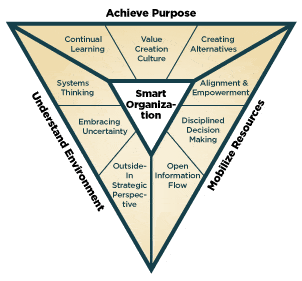In my last ValuePoint, I introduced the concept of the Strategic Intelligence of an organization, and described it by the embodiment of Nine Principles of the Smart Organization, as illustrated in the figure. This kind of Organizational Intelligence, among other things, enables organizations to continually innovate and stay ahead of the competition. In that article and in my follow-up blog, I distinguished this capability from Operational Excellence needed to scale-up and efficiently produce and sell world-class products. Unfortunately great innovators often get caught up in Operational Excellence to the detriment of Strategic Intelligence, and lose their ability to compete with the new innovators: It happened to Kodak, NEC, DEC, and almost killed Motorola when they refused to enter the digital cell phone age because of their leading position in analog. This loss of intelligence is not necessary: the concept of the Smart Organization is a basis for measuring and maintaining innovative health.
Three facets, at the top of the Figure, describe the organizational mind-set and tools for strategically ACHIEVING PURPOSE. “Value Creation Culture” means understanding what value the organization seeks and how they are motivated to pursue ways to create value, for example, better ways to serve customers and generate profits. “Creating Alternatives” describes the culture’s ability to create and develop new alternatives for achieving value and “Continual Learning” describes the organization’s dedication to seeking new ideas and ways of fulfilling its purpose.
UNDERSTAND ENVIRONMENT describes how the organization conceptualizes, engages, measures and understands potential threats and opportunities.

When dealing with the future, it is necessary to perceive and vet uncertainty and to turn this understanding into organizational advantage, which we call “Embracing Uncertainty.” When a client asked me “Why would you ever actually want to embrace uncertainty?”, I replied that investors buy stocks in order to take calculated risks. If you don’t figure out how to profit from uncertainty you are not serving investors or your customers very well. For innovators, Embracing Uncertainty means finding out more about how the world works and using this understanding to develop products and services that customers really want to buy, which might include experimenting in new business arenas until you get it right. “Outside-In Strategic Perspective” means beginning with what is happening in the outside world, how is the world changing, especially the world of your current and potential customers, how these changes impact the basis of competition, and only lastly how can my organization compete in this changing world? Contrast this with fitting your past revenue and projecting a line of growth forever – the world will not comply with your expectations! This analysis can get complicated, so you need “Systems Thinking” to put it all together. Use the insights developed above to project a number of uncertain worlds, and then develop alternatives to address these environments and evaluate the impact on value. This analysis usually requires building a quantitative decision model using Einstein’s maximum, “make it as simple as possible, but no simpler.” It is easy to complexify and a rare skill to simplify by extracting insights into what really is making your future tick.
The centerpiece of MOBILIZE RESOURCES on the right of the triangle, “Disciplined Decision Making,” describes how an organization musters its resources to develop and deliver innovative products and services. Does someone at the top get reports and make the call? Do cross-organizational teams work the problem, and with what tools? How does the need for a decision surface, and what is the process for making the decision? Does your organization have a high-quality procedure involving all the right people and coming to high-quality insights and decisions? In addition, good decisions require that “Open Information Flow” to all stakeholders. “Alignment and Empowerment” determines how successfully a decision to move in a new direction is implemented. This often means involving both top executives and key implementers early in the decision process, to gain their inputs, understanding and support for implementation.
How Smart is Your Organization?
I plan to expand at greater length on this important topic in future articles. In the meantime, I would like to give you a chance to gain deeper understanding about your organization by taking an “Organizational IQ test.” The 10-question on-line test measures an organization’s IQ in terms of application of the Nine Principles, not the IQ of the individuals within the organization.
To rate your organization, contact us and pick an organizational unit with which you are familiar, for example an R&D or NPD unit of your company or an entire division. Provide background information and respond to the 10 questions. We will analyze your responses and compare them with thousands of responses in our database to determine an Organizational IQ for the unit you have selected, and return the analysis to you by email. Your response will remain confidential with results aggregated into our ongoing database.
We will report results and make suggestions for change in a future issue of ValuePoint.



